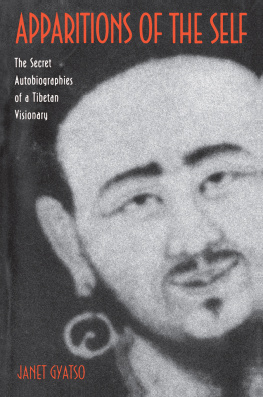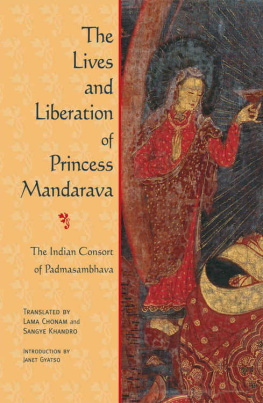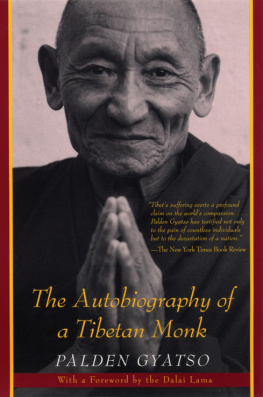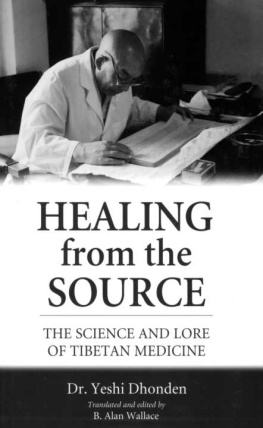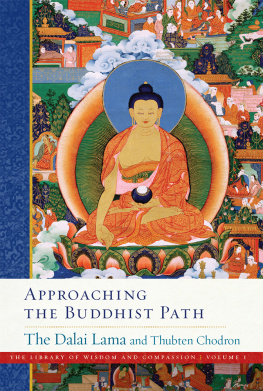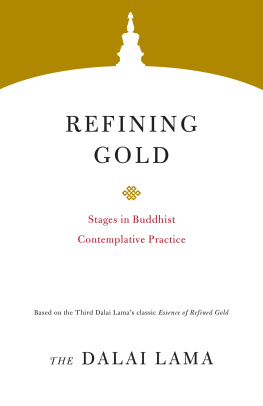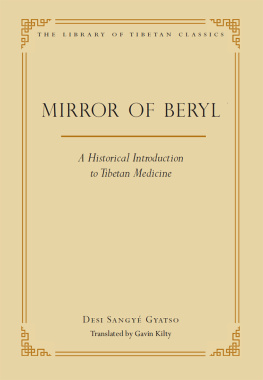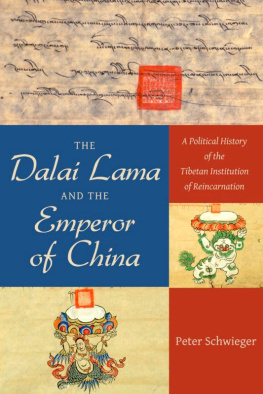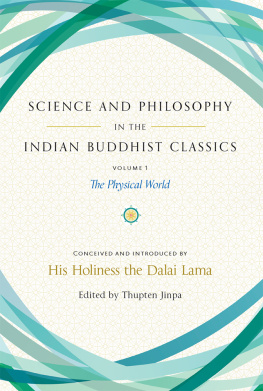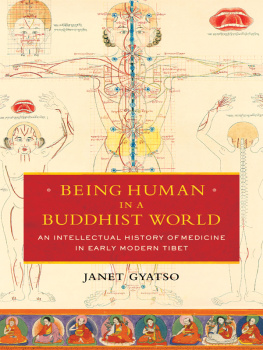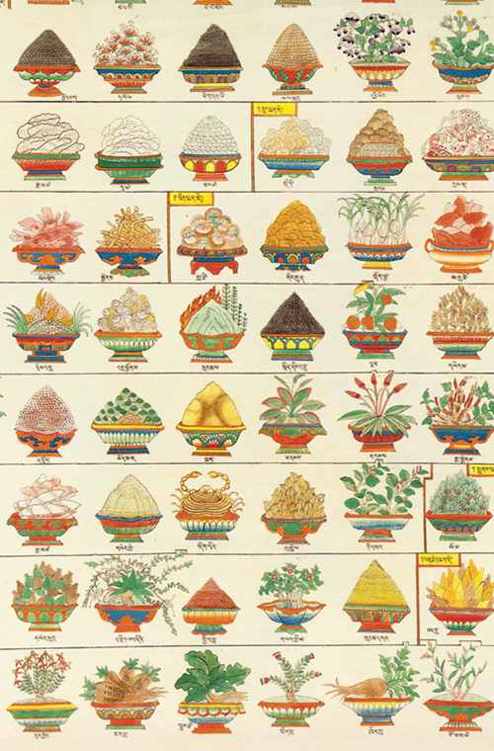BEING HUMAN
IN A
BUDDHIST WORLD
BEING HUMAN
IN A
BUDDHIST WORLD
AN INTELLECTUAL HISTORY OF MEDICINE IN EARLY MODERN TIBET
JANET GYATSO
COLUMBIA UNIVERSITY PRESS NEW YORK
Columbia University Press would like to express its appreciation for assistance given by
A special thanks to the Shelley & Donald Rubin Foundation for crucial financial support toward the publication of this book.
COLUMBIA UNIVERSITY PRESS
Publishers Since 1893
New York Chichester, West Sussex
cup.columbia.edu
Copyright 2015 Columbia University Press
All rights reserved
E-ISBN 978-0-231-53832-9
Library of Congress Cataloging-in-Publication Data
Gyatso, Janet, author.
Being human in a Buddhist world : an intellectual history of medicine in early modern Tibet / Janet Gyatso.
pages cm
Includes bibliographical references and index.
ISBN 978-0-231-16496-2 (cloth : alk. paper) ISBN 978-0-231-53832-9 (electronic)
1. BuddhismTibet RegionHistory. 2. Medicine, TibetanHistory. 3. MedicineReligious aspectsBuddhism. I. Title.
BQ7584.G83 2015
294.3'366109515dc23
2014005127
A Columbia University Press E-book.
CUP would be pleased to hear about your reading experience with this e-book at .
COVER AND FRONTISPIECE ART: Tibetan Medical Paintings: Illustrations to the Blue Beryl of Sangye Gyamtso (16531705). Plate: 9, detail.
COVER AND BOOK DESIGN: Lisa Hamm
References to websites (URLs) were accurate at the time of writing. Neither the author nor Columbia University Press is responsible for URLs that may have expired or changed since the manuscript was prepared.
CONTENTS
W orking on this project has been immensely pleasurable and engrossing. It has also posed considerable challenges in the research it called for and especially in matters of interpretation. The challenges were very much ameliorated and the pleasure greatly enhanced by my fortune in having the occasion to discuss many of the books issues with my learned colleague (and erstwhile student) Yang Ga, now associate professor at the Tibetan Medical College in Lhasa. This consultation took place during the period when he was a doctoral student in Inner Asian and Altaic Studies at Harvard, between 2003 and 2010. Not only was Yang Ga crucial to the project in pointing me to key resources and helping me to puzzle through difficult passages. He also has been a true partner in thought, an exemplary combination of his traditional education in medicine and his modern academic one, learning from both how to be critical of easy readings and assumptions. He is also very finely attuned to rhetorical ploy. This book would be greatly diminished without his generous collaboration, if it were even possible at all.
I have also had the benefit of illuminating discussions on the history and theory of medicine with Tupten Pntsok, now at the Southwest Minorities University in Chengdu. He was the first to introduce me to the riches of the Four Treatises and the thought of Zurkharwa Lodr Gyelpo, during a course on medicine that he gave at the Shang Shung Institute in Conway, Massachussetts, more than a decade ago. I am indebted too to Sonam Chim of the Tibetan Medical College and other senior students of the Venerable Troru Tsenam in Lhasa for providing me with photocopies of manuscripts, and to Denpa Dargye at the China Tibetology Research Center and Dr. Tashi at the Tibetan Beijing Hospital for answering my questions on pulse diagnostics, as kindly facilitated by Tsering Thar of the Central Minorities University in Beijing.
No one has been more stimulating to my thinking on the conceptual issues of this book than Charles Hallisey. He read many versions of parts of this project and his probing comments, not to mention countless references in fields far beyond Asian Studies, prompted me to frame the questions of the book in terms of large foundational issues for the history of thought. Conversations with Steven Collins over the years have contributed critically to my ongoing interests in the nature of historical thinking and the grounds of truth claims. I am also grateful to Sheldon Pollock for inviting me to contribute an essay to a collection on knowledge in early modern South Asia, which led me to recognize central issues in this project around modernity. Responses to an essay on some of these same issues at a faculty workshop at Harvard Divinity School supported by the Richard T. Watson Chair in Science and Religion brought my comparative thinking on early modern science in Europe to greater precision, especially comments by Amy Hollywood and Mark Jordan. I am grateful too for incisive questions on a set of lectures that I gave at the Wellcome Trust Center for the History of Medicine in London from Harold Cook, Vivienne Lo, and Ronit Yoeli-Tlalim. A lively colloquium organized by Indrani Chatterjee at the Rutgers Center for Historical Analysis also inspired me to broaden the scope of the questions I was bringing to the project at a formative moment in its development.
The late E. Gene Smith generously gave me many references in Tibetan cultural history over the course of this project; indeed, the impact of his enormous knowledge, always bestowed unstintingly, on my entire career in Tibetan Studies cannot be overestimated. Conversations with Matthew Kapstein over the years have also had a great impact on my appreciation of the history of Tibetan religion and society; I am particularly grateful as well for the very detailed comments he made on the manuscript as a reader for Columbia University Press. Kurtis Schaeffer made extremely helpful comments as well in the same capacity, as did Vesna Wallace, and this book has benefited accordingly. Critical input from David Shulman vastly improved the quality of the translations in this book. I owe thanks to many other colleagues and students in Tibetan Studies for helpful references and illuminating conversations on aspects of this project, especially Jake Dalton, who conveyed comments from his seminar at the University of California at Berkeley on a penultimate draft of the book manuscript, as well as Vincanne Adams, Ben Bogin, Bryan Cuevas, Rae Dachille, Georges Dreyfus, Frances Garrett, David Germano, Jonathan Gold, Amy Heller, Theresia Hofer, Sarah Jacoby, Samten Karmay, Deborah Klimberg-Salter, Leonard van der Kuijp, Donald Lopez, Robert Mayer, Arthur McKeown, Willa Miller, Robert Pomplun, Andy Quintman, Joshua Schapiro, Michael Sheehy, Elliot Sperling, Heather Stoddard, Tashi Tsering, and Gray Tuttle. I am also grateful to colleagues in Buddhist Studies for their assistance and reflections, including Collett Cox, Michael Hahn, Paul Harrison, Maria Heim, Robert Kritzer, Ryan Overbey, and Robert Sharf; to Sokhyo Jo, Natalie Koehle, Philip Kuhn, Michael Puett, Michael Radich, James Robson, and Pierce Salguero for very helpful suggestions, references, and ideas regarding East Asian science and cultural history; and to Daud Ali, Shrikant Bahulkar, Donald Davis, Wendy Doniger, Paul Dundas, Robert Goldman, D. Christian Lammerts, Anne Monius, Narayana Rao, and John Taber for an array of comparative reflections on the history of science and related fields in South Asia.


